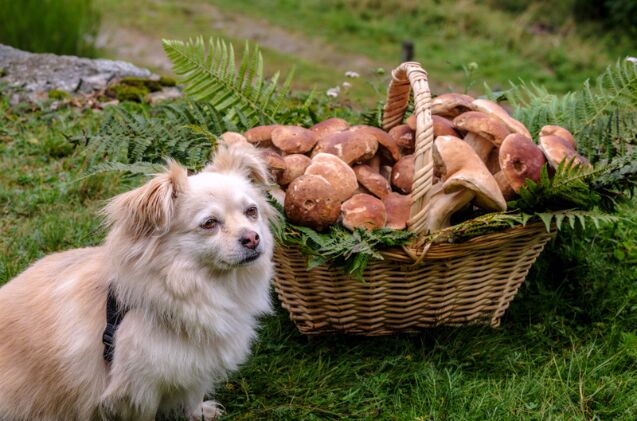What Do I Do If My Dog Eats Wild Mushrooms?

If you hike or adventure with your dog, you have likely encountered wild mushrooms during your travels – especially now that we are entering the autumn season. But here’s the problem: they’re not always safe for our furry friends. As dog parents, it’s our responsibility to learn about the dangers that wild mushrooms may pose to our dogs and how to keep them safe.
In this blog post, we’ll discuss everything you need to know about wild mushrooms, including how they could spell trouble for your dog and what you should do if your pup decides to chow down one of these potentially toxic fungi. Recognizing the signs of mushroom toxicity and knowing what steps to act promptly could make all the difference.
So, let’s dive into the world of wild mushrooms and get you prepared to protect your canine companion.
Can Mushrooms Harm a Dog?
There has been a lot of talk recently about the benefits of medicinal mushrooms for both humans and pets. While studies and research are still being conducted to fully understand the impact mushrooms can have as a supplement or alternative treatment option, it’s clear that some fungi can be incredibly helpful. Still, there are also a few that are highly toxic both to us and our furry friends.
The challenge when discussing wild mushrooms is that most dog parents aren’t foraging experts with a knowledge of which mushrooms are edible and which are not – and our dogs certainly aren’t educated on the topic!
If you are out hiking and your dog discovers a mushroom on the side of the trail, you likely aren’t going to know in advance whether it’s toxic or not. In fact, if you have a high-energy dog like we do with our pup Lucifer, you may not even have the opportunity to see the mushroom enough to identify it before it has been ingested. This means leaving the possibility that it could be a toxic variety up to chance. For this reason, it’s safer to steer clear of wild mushrooms entirely.
Does this mean that your grocery store mushrooms are dangerous?
No. If you have purchased mushrooms to cook up for dinner and you want to share one with your dog, they are safe. They are healthiest when offered raw, but if you do cook them, ensure they are unseasoned, as the seasoning could upset your dog’s stomach. They can also be found in some foods, treats, supplements, and bone broth products.
What Does Mushroom Toxicity Look Like in Dogs?
While we have established that allowing your dog to eat wild mushrooms is unsafe, the hard truth is that we can’t always control the situation. Simply looking away for a matter of seconds may be all it takes for your dog to find and grab a mushroom on the side of the road, on a trail, or even in your backyard. For this reason, we must ensure that we are familiar with the signs of mushroom toxicity to recognize the problem and react as quickly as possible.
There are four categories of toxic mushrooms:
Gastrointestinal
Mushrooms in this category primarily impact your dog’s digestive system. They act quickly, showing signs in as little as 15 minutes after ingestion. These are the most common signs your dog has ingested a gastrointestinal mushroom:
- Excessive drooling
- Upset stomach
- Abdominal pain
- Vomiting
- Diarrhea
Neurotoxic
These mushrooms cause neurological symptoms and, if not addressed quickly, can often be fatal. Signs often show approximately 30 to 90 minutes after ingestion. The most common signs that your dog has eaten a neurotoxic mushroom include:
- Digestive upset
- Weakness
- Agitation or anxiety
- Loss of coordination
- Unsteady gate
- Appearing confused or disoriented
- Tremors
- Seizures
Hepatotoxic
These mushrooms are significantly more dangerous than the first two categories. They are slower acting, with symptoms appearing as long as 12 hours after eating the mushroom. They begin by upsetting the digestive system and may be initially mistaken for a gastrointestinal mushroom. However, after time, they will start to impact the function of your dog’s liver, leading potentially to liver failure and death if not addressed.
Nephrotoxic
Finally, this category is very similar to hepatotoxic mushrooms in that it begins as a digestive upset. If unaddressed, these mushrooms can cause kidney failure or acute renal damage.
What Do I Do if My Dog Ate a Wild Mushroom?
If you notice any of the above symptoms of mushroom toxicity in your dog, contact your veterinarian or the nearest emergency clinic as soon as possible. If there are multiple mushrooms in the area and you can take a sample for identification, it may help provide valuable insight.
While no treatment can instantly fix the toxicity, your veterinarian can provide your pup with supportive care. This will begin with inducing vomiting and/or giving your dog activated charcoal to remove or cancel out the poison and prevent further damage.
The vet will monitor your dog while providing supportive care to address symptoms or complications of the toxicity, such as IV fluids to prevent dehydration and anti-nausea medications to settle digestive problems. This takes the unnecessary strain off the body, significantly boosting your dog’s chance of survival.
5 Tips for Preventing Mushroom Toxicity in Dogs
When it comes to toxins like wild mushrooms, the best approach is to prevent your dog from getting into trouble before it even happens. Of course, if you’re a frequent hiker or outdoor adventurer, keeping your dog away from wild mushrooms (especially during the autumn months) can feel challenging or even impossible. Luckily, there are some steps we can take to reduce the risk and set our dogs up for success.
Learn About Your Local Risks
They say knowledge is power, which is also true when protecting your dog from natural hazards like toxic plants and mushrooms. Take some time to learn about which mushrooms are found in your area and if there are specific locations where they are more prevalent. You can use this information to try to plan safer trips. For example, if you know that during October, there is a higher number of questionable mushrooms on a favorite woodland trail, you may skip that spot or be extra vigilant while there.
Inspect Your Property Regularly
We keep referring to the risk of encountering toxic mushrooms while hiking, but that isn’t the only place your dog may discover them. There is a chance you may have fungi growing right in your backyard, accessible to your dog each time you let them out to go to the bathroom.
The best way to prevent this is to regularly walk around your property, looking for signs of trouble. If you spot mushrooms growing in your yard, you can remove them before your dog can access them. But be warned – if they have grown in one area of the yard before, they likely will again! Moving forward, that area should be considered a high-risk zone that is inspected more frequently.
Common areas to find mushrooms include in and around compost piles, tree roots, tree stumps, fallen trees or branches, yard waste piles, and other decaying organic matter.
Consult an Identification App or Field Guide
As we previously discussed, only a small percentage of mushrooms are toxic. For some, this could lead to an interest in learning which mushrooms in your area can be harvested for consumption and which should be avoided. There are no easy identifiers when trying to spot toxic mushrooms – they don’t smell different, and you aren’t going to notice based on initial taste. Instead, you will need to consult the characteristics listed in these guides. If there are any questions about whether a mushroom fits the description completely, err on the side of caution.
For those seriously interested in getting into foraging, consider joining a local outdoor skills organization or mushroom club. Many of these groups will run guided hikes where they answer your questions and show you firsthand how to identify plants and fungi that are safe to consume.
Consider Leashing Up
Do you have a dog that has a habit of wandering off the trail and exploring their surroundings? Even if your pup has a rock-solid recall, it only takes a couple of seconds in a location where you can’t see them to eat something they shouldn’t. The best way to prevent this is to return to the basics – using a leash on your adventures.
There are many great options to choose from. When hiking with my dogs, we prefer using a hands-free leash setup. There are many different brands and varieties to choose from. The most basic setup that we have and use regularly with our dogs is The Buddy System. It’s lightweight, comfortable, and gives us the security of knowing that we can keep the pups nearby where they can be carefully monitored.
Train the “Drop It” Command
Have you ever been in a situation where your dog has picked up something they shouldn’t, and you’re scrambling to remove it from their mouth? Not only do dog parents often fail to pry items out of their dog’s mouth, but they also get injured during the struggle! Instead, consider training your dog to obey a cue to instantly drop or let go of anything they may have picked up. The most common verbal command used for this is “Drop It.”
To start teaching “Drop It,” you will need two items (toys or treats) – one they like and one they LOVE.
Begin by placing the tempting item they like, the lower-value toy, on the ground. When your dog picks it up, offer to trade them for a higher-value toy. Praise and reward them when they drop the toy to make the exchange. For example, with Lucifer, his highest-value toys are his KONG Squeezz balls. So, I would praise him and play a short game with the ball before repeating this sequence. For food-driven dogs, consider high-value treats like Stella & Chewy's Freeze-Dried Raw Beef Heart Treats.
In time, you can increase the value of what you are asking your dog to give up. Eventually, phase out showing them the higher value item. This doesn’t mean not to praise and reward – but focus on asking them with the cue and then rewarding them for doing it. Your dog will learn that giving up whatever they have will always result in something better.
Final Thoughts: Toxic Mushrooms and Your Dog
Most mushrooms you will find in North America are non-toxic, but there are a small number that could be dangerous, even life-threatening. Unless you are experienced and knowledgeable in foraging and mushroom identification, assuming that every mushroom you encounter while out with your dog is dangerous is safer.
When hiking or adventuring with your dog, keep a close eye on them. If they tend to wander, use a leash in high-risk situations, like hiking through a woodland area during autumn. You may even want to avoid some areas when you know the risk is exceptionally high. Learn to recognize the warning signs of mushroom toxicity and how to react accordingly. After all, accidents happen, and your ability to respond quickly may save your dog’s life.

Britt Kascjak is a proud pet mom, sharing her heart (and her home) with her “pack” which includes her husband John, their 2 dogs – Lucifer and Willow – and their 2 cats – Pippen and Jinx. She has been active in the animal rescue community for over 15 years, volunteering, fostering and advocating for organizations across Canada and the US. In her free time, she enjoys traveling around the country camping, hiking, and canoeing with her pets.
More by Britt
























